This will be the third piece of my series in which I use data to find the best Austrian players for several positions. In the last two articles, the topic was the back four as I looked at the centre-backs and full-backs respectively. In this data analysis, we’ll go further up the pitch and find the best defensive midfielders for the Austrian national team by using data and statistics.
Within the last two pieces of the series, we found, beside the players who are the regular starters in the Austrian national team, young talents with solid metrics who could become relevant for Franco Foda within the upcoming months and years. Both times, the talents (Johannes Handl and Lukas Prokop) were players of Austria Vienna II. Considering this, it will also be interesting if we find one or two players of the second squad of Austria Vienna for the defensive midfielders as well. All statistics which are used in this data analysis are the average values per 90 minutes.
Comparison
Before we look at a few key values for defensive midfielders, I need to mention the filters to understand which players will show up in the graphs. The three central filters were that the players need to be Austrians and have played at least 998 minutes as a defensive or central midfielder in this season for their respective clubs. Furthermore, all men who play in Austria’s second division and are not 22 years old or younger got taken out of the pool of central and defensive midfielders since a player who is that old and still in the second division isn’t and won’t be interesting for Foda within the upcoming months and years.
The German head coach of Austria mainly lines his team up in a 4-2-3-1 formation with two defensive midfielders and the basic tactics are a dominant and possession-based style of play combined with a high and aggressive pressing and counter-pressing.
Before we look at the statistics which will be important to find players who are comfortable on the ball which they need to be as they have a central role during the build-up, we will use data to find the defensively strongest players. For this, we’ll use the stats for their successful defensive actions per 90 minutes and their average success rate in defensive dues (in %) which are visualised in the graph below.
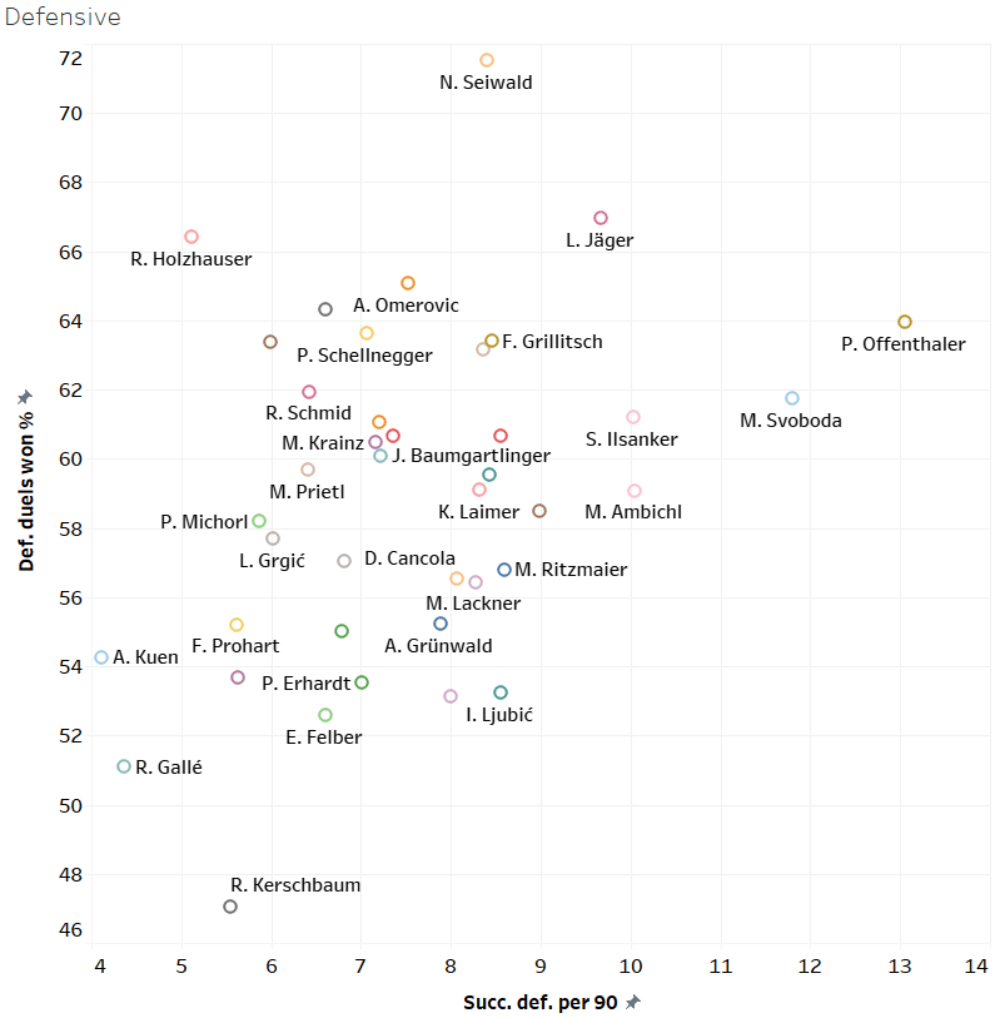
Nico Seiwald and Philipp Offenthaler are the two players who stand out in these categories as Seiwald wins the most of his defensive duels (71.52%) and Offenthaler makes the most successful defensive actions per game with 13.05. However, at this point, I need to note that both play in Austria‘s second division, but both are still young. Especially Seiwald (18 years old) who is a promising talent of RB Salzburg’s second team, FC Liefering. Offenthaler is 22 and one of the most important players of Amstetten but clearly needs to join a team in the Austrian Bundesliga as soon as possible to showcase his abilities on a higher level.
Next, we will look at the statistics of the Austrian players which should indicate if they are important for the build-up at their respective clubs since the defensive midfielders in Austria’s 4-2-3-1 should be able to organise the progression of the ball together with the central defenders. The two statistics which we look at will be the average number of passes per 90 minutes and additionally the success rate of these to see how well they do when it comes to passing the ball. The results can be seen in the image below.
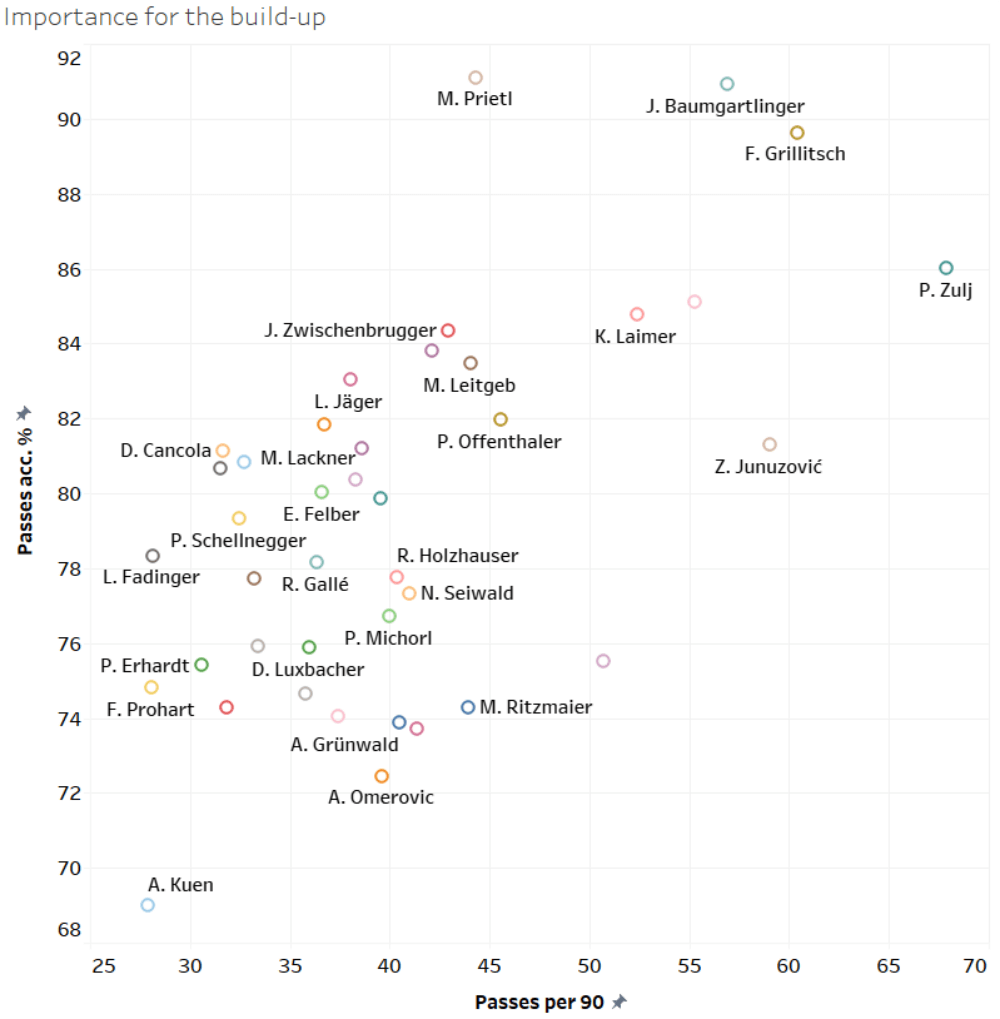
Manuel Prietl of Arminia Bielefeld (2. Bundesliga) is one of several Austrian midfielders who play in Germany and is the one with the best success rate as 91.11% of his 44.32 passes per match find his teammates. RSC Anderlecht’s Peler Zulj is the Austrian with the most passes per 90 minutes with 67.9.
Florian Grillitsch (Hoffenheim) and Julian Baumgartliner (Bayer Leverkusen) are the two other players who have great values as they are really solid in both categories. Baumgartlinger plays 56.87 passes per match with 90.94% of them successful, while Grillitsch has a slightly lower value for the accuracy with 89.64% but plays more passes (60.39).
Even though these values tell us perfectly which players are the ones who have the abilities to organise a build-up, we still don’t know which type of passes they play and if they are also able to progress the ball further up the pitch. Due to that, we will now use once more data to create a graph which should tell us which defensive (or central) midfielders are not just the ones who organise their team’s build-up but also work for the actual progression of the ball.
Considering this, we’ll use now the average values for the progressive passes and progressive passes per 90 minutes as we can see in the graph below.
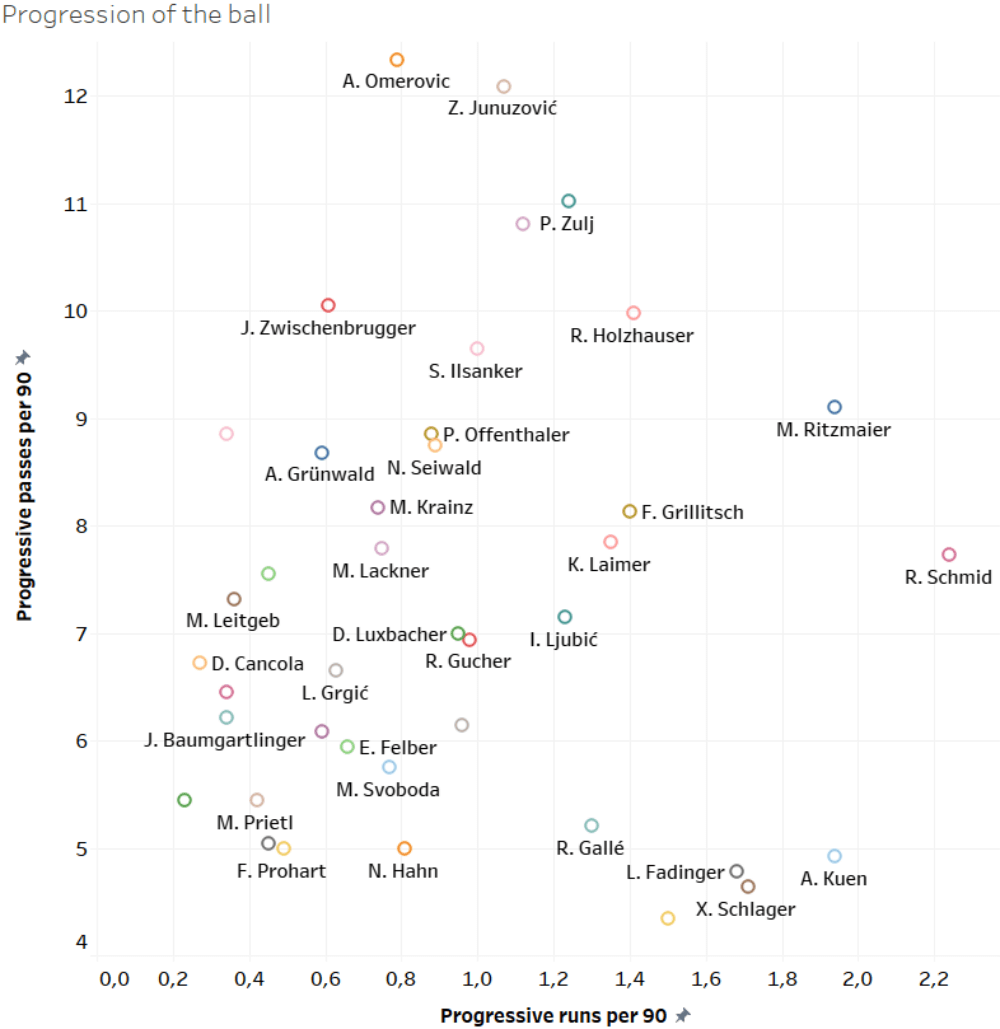
While the other statistics which we used earlier in this data analysis influenced each other as a higher success rate in defensive duels leads to more successful defensive actions, and more passes make it harder to have a high success rate for them; progressive passes and progressive runs don’t have a direct influence on each other.
Due to that, we have players who have amazing values for one category but the other one is below average. For example, Romano Schmid has a value of 2.24 for progressive runs per game which is the highest number of all players, but he just makes 7.73 progressive passes per 90 minutes. On the other side, Anes Omerovic is the one with the most progressive passes (12.34), but only makes 0.79 progressive runs per game.
Next, we will look at five players who caught my attention in the comparison of all defensive/central midfielders.
Konrad Laimer, 22 years old, RB Leipzig
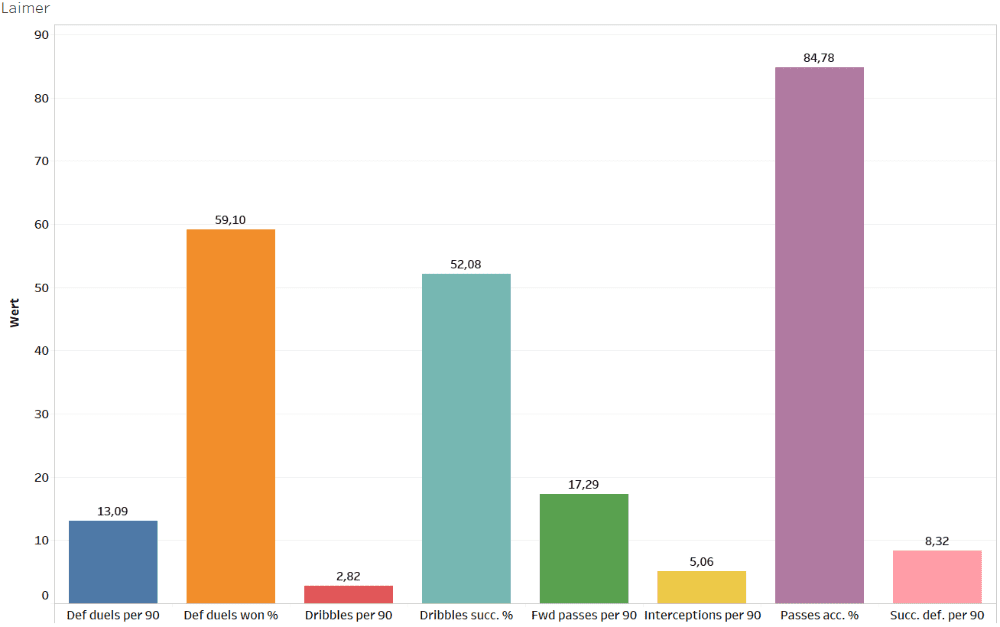
Laimer is already at this early stage of his career one of the best defensive midfielders of the Bundesliga for a lot of people and also of Austria. Basically, the most important aspects of his style of play are his aggression and intensity. One clear indicator for that is that he is involved in 13.09 defensive duels per game (highest value of all players in our pool). An additional reason for that incredibly high value are the tactics of RB Leipzig since their style of play is also quite intense and due to that, the Austrian midfielder perfectly fits into their squad and tactics.
Also, he is among the most favoured players of Foda and played in seven out of the 10 games of the Qualifiers for the Euros 2020. Furthermore, with 2.82 dribbles per game, he is among the Austrians in this position who attempt the most dribbles. In these situations, he tries to make use of his acceleration and pace to carry the ball forward. Additionally, he is with 0.15 goals and 0.12 assists per 90 minutes a central midfielder who likes to get forward and support his teammates in the final third.
Julian Baumgartlinger, 32 years old, Bayer Leverkusen
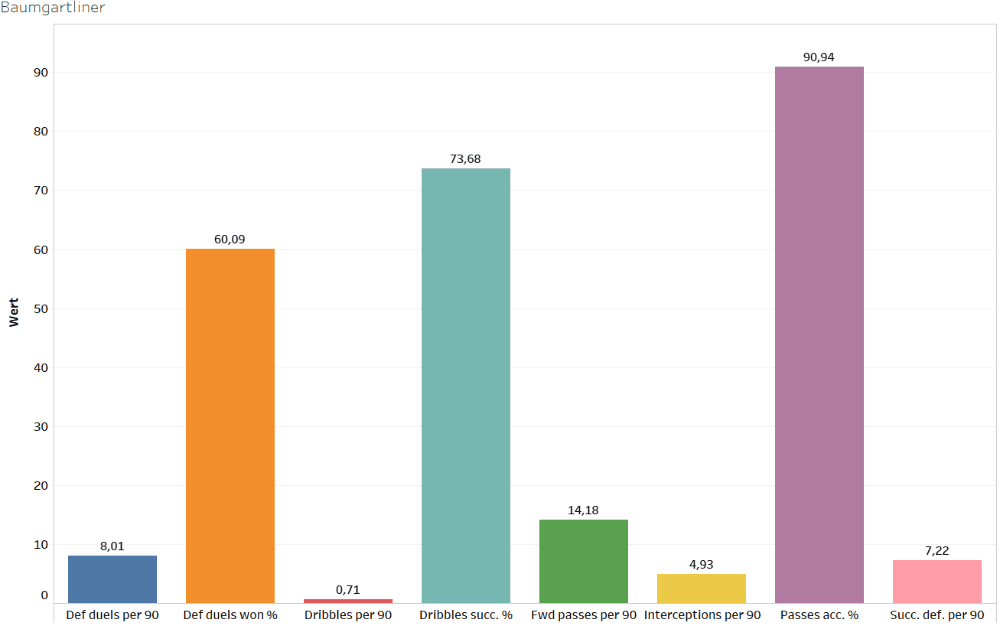
The 32-year-old defensive midfielder of Leverkusen debuted in 2009 for the Austrian national team and is since then a central part of the squad. Within the last couple of years, he also became the captain of Austria. While the other four players at which we take a more detailed look in this data analysis are more central midfielders or more offensive-minded defensive midfielders, Baumgartlinger is an out-and-out defensive midfielder whose strengths are clearly the defence and the organisation of the build-up.
As we already saw earlier in one of the graphs, he’s really important for Leverkusen’s build-up as he plays 56.87 passes per game with an accuracy of 90.94. However, he doesn’t play that many forward passes (14.18) and also the values of the progressive runs (0.34) and progressive passes (6.21) are quite low. These statistics clearly tell us that Baumgartlinger is a defensive midfielder who is good in dictating the build-up but he’s not among the ones who are responsible for the actual progression of the ball.
Peter Zulj, 26 years old, RSC Anderlecht
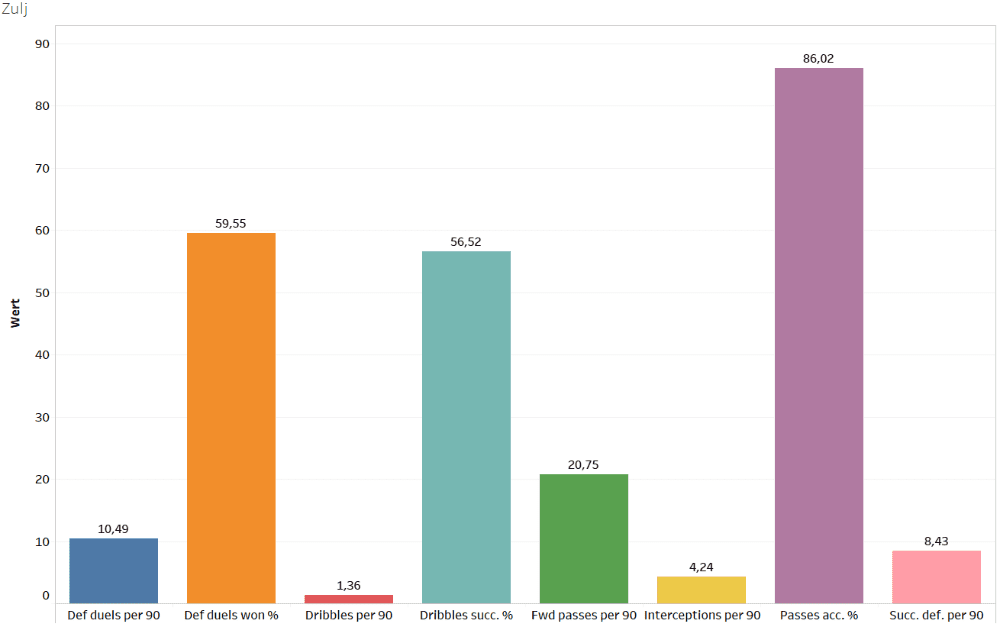
Zulj is one of the very few Austrian players who neither play in Austria, nor in the German Bundesliga as he has currently a contract at Anderlecht in Belgium. The central midfielder played in the youth for RB Salzburg and already made 10 appearances for the national team of Austria, but the last one was over one year ago. However, Foda was the coach who is responsible for him debuting for Austria (he never played a game under Marcel Koller) back in 2018.
The main reason why I want to look at some of his statistics in more detail is that he stood out in the graph for the passes and their accuracy and was also among the players with the best values for progressive runs and progressive actions.
With 67.9 passes per game, he’s the Austrian midfielder in our pool with the highest value for that metric and still has an excellent success rate (86.02%). But compared to Baumgartlinger, he also makes quite a lot of progressive actions (11.02 passes and 1.24 runs). So, he doesn’t only look for the easy pass, but also the ones who bring the ball further up the pitch. With 8.43 successful defensive actions and 4.24 interceptions per game, he is indeed not among the defensively best Austrian midfielders, but these values aren’t extremely weak. Especially when you consider that Anderlecht had a really complicated season.
Florian Grillitsch, 24 years old, Hoffenheim
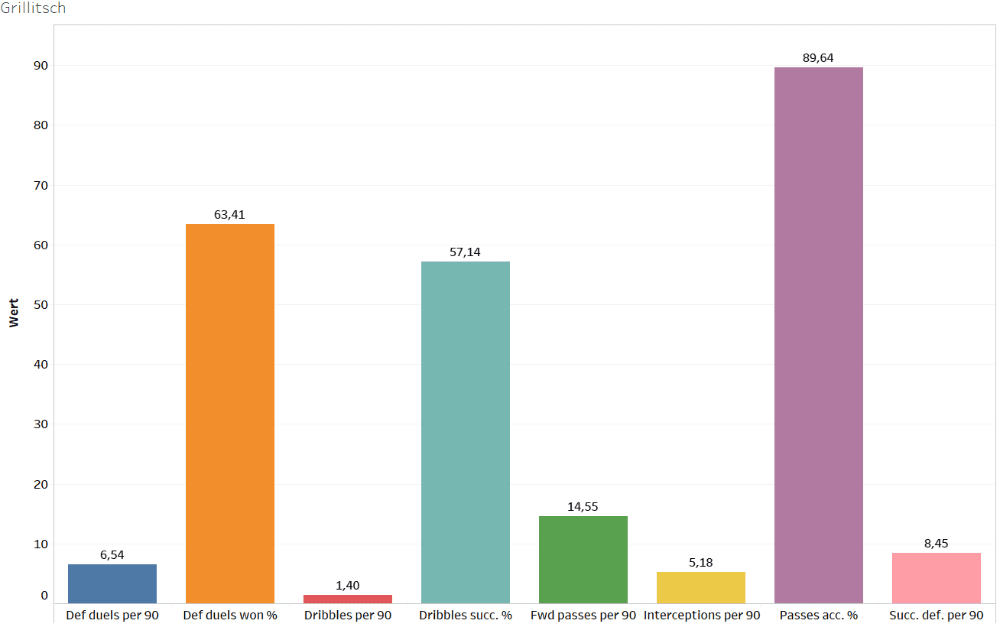
The 24-year-old central midfielder already made 15 appearances for Austria, debuted in 2017 and has a contract at Hoffenheim until 2022. Grillitsch is an important part of Alfred Schreuder’s team as he played in 23 out of the 25 games in the Bundesliga in 2019/20.
The central midfielder was also among the players who stood out in the graph considering the importance of the build-up as he plays on average 60.39 passes per game with a success rate of 89.64%. He is among the best three players of all Austrian midfielders which are in my pool for both statistics.
With a success rate of 63.41%, Grillitsch is quite strong in defensive duels, but he’s not a player who is frequently involved in them as his data tells (6.54 defensive duels per 90 minutes). The 24-year-old is indeed one of the more offensive-minded players in this data analysis with 6.98 passes to the final third and 1.51 through passes (both per 90 minutes).
Nico Seiwald, 18 years old, Liefering
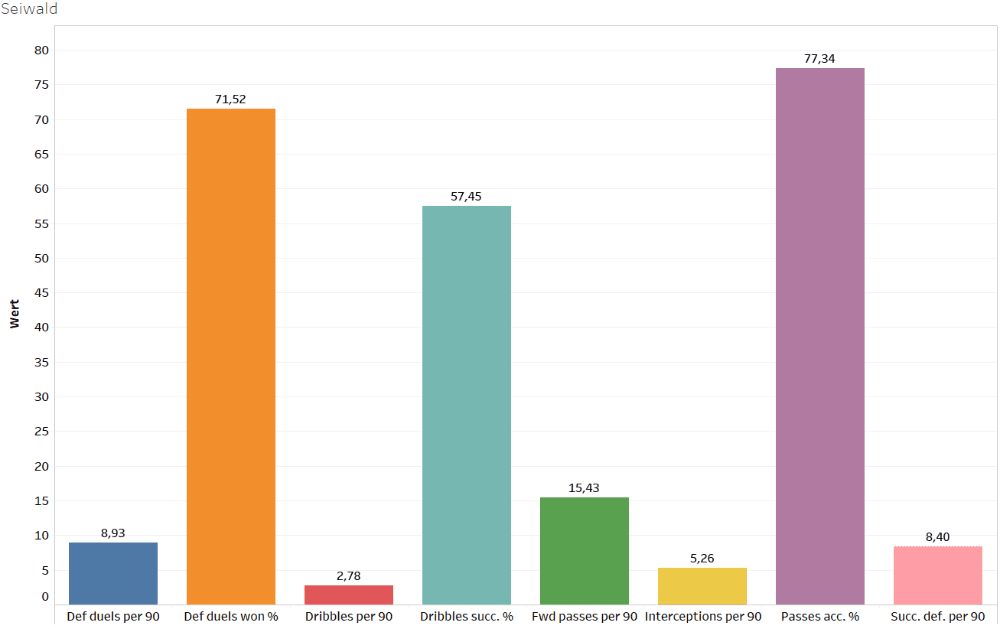
While until now we have seen four players who are either regular starters of Austria’s national team or on the edge of being that, the fifth and last one is one of the greatest talents of Austria as Seiwald stood out in the first graph with an amazing success rate of 71.52% in defensive duels. But, with 2.78 dribbles and 15.43 forward passes per game, we can also see that he is strong on the ball and is a player who is able to bring the ball forward. Also, 57.45% of his dribbles are successful which is a good value and he makes 5.26 interceptions per game. With that, he is among the best players in this category in this data analysis.
Of course, you have to consider that he plays in Austria’s second division which isn’t on the same level as the Austrian or German Bundesliga, but still, he has decent statistics for an 18-year-old. It will be interesting to see if and when he will be promoted to the first team of RB Salzburg.
Conclusion
We saw in this data analysis that Austria have a bunch of young and talented defensive and central midfielders. Besides young players like Laimer or Grillitsch who already play on an incredibly high level, there are also players like Seiwald or Schmid who could become good players within the upcoming years.
Additionally, I want to note that Zlatko Junuzović is indeed one of the players who stood out in the graphs and RB Salzburg’s central midfielder is still one of the best Austrians in his position, but he already retired from the national team and due to that I didn’t take a closer look at his statistics.
In the upcoming week, we’ll use in the next article of this series, data to find the best wingers of Austria.





Comments